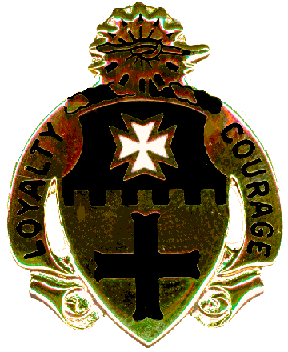5th Cavalry Lineage/Honors

DEPARTMENT OF THE ARMY
Lineage and Honors
5th CAVALRY
"LOYALTY AND COURAGE"
The design of the regimental shield centers on a cross moline sable, on a chief embattled of the last a Maltese cross argent. The field is yellow for the Cavalry. The cross moline symbolizes the charge of this regiment on Longstreet's troops at Gaines Mill in 1862; a charge which saved the Union artillery and which is characterized by the regimental historian as "its most distinguished service". The cross moline is supposed to represent the iron pieces of a mill stone (moulin, the French word for mill). The chief is for the Puerto Rican Expedition of 1898. The original name of the island was San Juan, named for the knights of St. John who wore a white Maltese cross on a black habit. The partition line is embattled to suggest the castle on the Spanish arms.
Constituted 03 March 1855 in the Regular Army as the 2nd Cavalry Regiment.
Organized 28 May 1855 at Louisville, Kentucky; Colonel Albert Sidney Johnston, commanding.
Re-designated 03 August 1861 as 5th Cavalry.
1883 Cavalry Companies officially designated as Troops.
Assigned 17 December 1917 to the 15th Cavalry Division.
Relieved 11 May 1918 from the 15th Cavalry Division.
Assigned 18 December 1922 to the 1st Cavalry Division.
Dismounted 28 February 1943.
Reorganized 04 December 1943 partly under cavalry and partly under infantry tables of organization and equipment.
Reorganized 20 July 1945 wholly as infantry but retained cavalry designations.
Reorganized 25 March 1949 with troops designated as companies.
Relieved 15 October 1957 from assignment to 1st Cavalry Division.
Reorganized 15 November 1957 as a parent regiment under the Combat Arms Regimental System
Withdrawn 16 February 1987 from the Combat Arms Regimental System and reorganized under the United States Army Regimental Systems with Headquarters at Fort Hood, Texas.
CAMPAIGN PARTICIPATION CREDIT
Civil War
Bull Run
Peninsula
Antietam
Fredericksburg
Chancellorsville
Gettysburg
Wilderness
Spotsylvania
Cold Harbor
Petersburg
Shenandoah
Appomattox
Virginia 1861
Virginia 1862
Virginia 1863
Virginia 1864
Maryland 1863
Indian Wars
Comanche's
Apaches
Little Big Horn
Nez Perces
Bannocks
Cheyenne's
Ute's
Texas 1856
Texas 1860
Oklahoma 1858
Oklahoma 1859
Arizona 1872
Arizona 1874
Philippine Insurrection
Streamer without inscription
Mexican Expedition
Mexico 1916 – 1917
World War II – Pacific Theater
New Guinea
Bismarck Archipelago with arrowhead
Leyte with arrowhead
Luzon
Korean War
UN Defensive
UN Offensive
CCF Intervention
First UN Counter Offensive
CCF Spring Offensive
UN Summer-Fall Offensive
Second Korean Winter
Third Korean Winter
Vietnam
Defense
Counter Offensive
Counter Offensive, Phase II
Counter Offensive, Phase III
Tet Counter Offensive
Counter Offensive, Phase IV
Counter Offensive, Phase V
Counter Offensive, Phase VI
Tet/69 Counter Offensive
Summer-Fall 1969
Winter-Spring 1970
Sanctuary Counter Offensive
Counter Offensive, Phase VII
Consolidation I
Consolidation II
Cease-Fire
Operation Desert Shield/Desert Storm
Defense of Saudi Arabia
Liberation of Kuwait
DECORATIONS
Presidential Unit Citation (Army), Streamer embroidered LOS NEGROS ISLAND (5th Cavalry, cited for the period 29 Feb to 04 Mar 1944; DA GO 16, 1949)
Philippine Presidential Unit Citation, Streamer embroidered 17 OCTOBER 1944 – 4 JULY 1945 (5th Cavalry, cited; DA GO 47, 1950)
Republic of Korea Presidential Unit Citation, Streamer embroidered WAEGWAN-TAEGU (5th Cavalry, cited for the period 16 Aug to 26 Sep 1950; DA GO 35, 1951)
Republic of Korea Presidential Unit Citation, Streamer embroidered KOREA (5th Cavalry and attached units, cited for the period 11 Jul to 01 Oct 1952; DA GO 24, 1954)
Republic of Korea Presidential Unit Citation, Streamer embroidered KOREA 1952 – 1953 (5th Cavalry, cited for the period 11 Jul 1952 to 1 Oct 1953; DA GO 24, 1954)
Chryssoun Aristion Andrias {Gold Bravery Medal of Greece}, Streamer embroidered KOREA (5th Cavalry, cited for the period of the war in Korea; DA GO 2, 1956)
